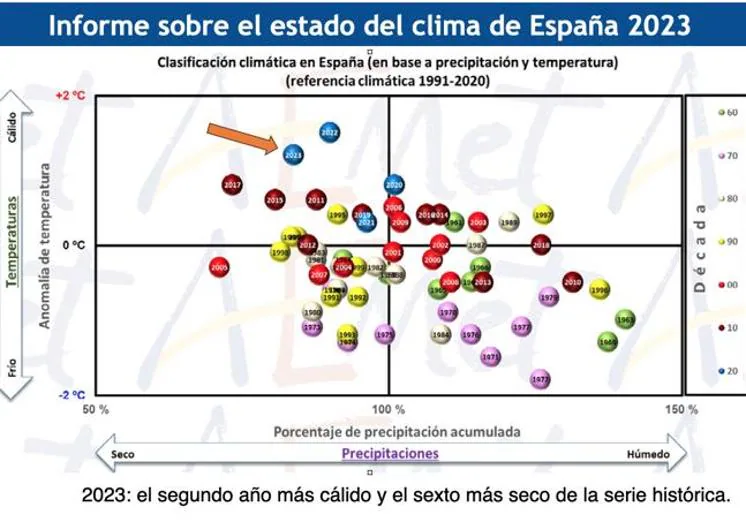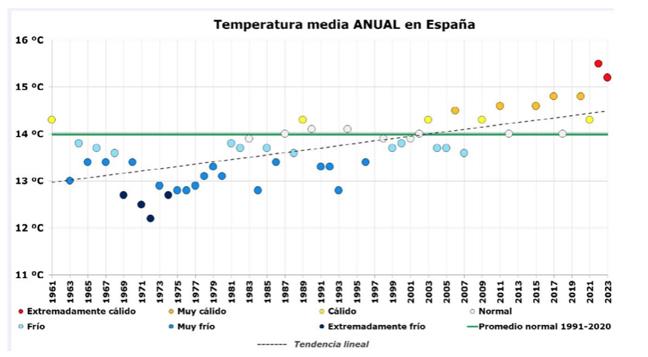

Sections
Highlight

Spain broke 44 warm-day records in 2023, nine more than expected, with no cold-day records. In an environment unaltered by climate change five records of each type would be expected. That is what is stated in the report on the state of the climate in 2023, presented on Thursday by the national weather agency (Aemet), which certified that 2023 was the second warmest year on record after 2022, with an average temperature for Spain as a whole of 15.2C (15.4C in 2022). It was also the sixth driest since 1961, when records began.
The report, which analysed in detail the most important aspects of the weather and climate throughout 2023, points out that in the last decade there have been 196 warm-day records for only seven cold-day records, which gives an idea of how global warming, caused by greenhouse gas emissions, is hitting our country, increasing the average temperature of the reference period 1991-2020 by 1.2C and by 1.5C since 1961.

"In 2022, which was the warmest year on record, there were 35 warm-day records, but in 2023 there have been nine more days with record heat, which is something that had never been seen before," said Aemet spokesperson Rubén del Campo at the presentation of the findings, an event that was also attended by president of the Aemet, María José Rallo, who noted that in the last ten years, for every record cold day, there have been 28 record warm days. You have to go back to April 2022 to find the last record cold day, 25 months ago. Del Campo said that so far in 2024 there have already been 19 warm-day records, four times more than normal, for no record cold days.
According to the report, all 12 months of 2023 were warm or extremely warm with the exception of January, February and May, which were normal in terms of temperatures. "This is the first year since 1961 in which no full month has been cold. The last one was April 2022. It has been more than two years without a cold month, something unprecedented and extraordinarily anomalous," said del Campo.
In addition, it was the warmest spring in the series, the third warmest summer and the second warmest autumn in terms of average temperature.
Although there were no cold-day records in 2023, there were two cold snaps. One of these, which started on 28 February, was the third latest since records began. However, high temperature episodes were clearly predominant. There were seven heat waves (four in the Peninsula and the Balearic Islands and three in the Canary Islands) and two episodes of high temperatures in April (with the thermometer reaching 40C in Cordoba) and in October. And on 12 August, the Guía de Isora weather station in Tenerife did not drop below 37.4C, the highest minimum temperature in Spain since data has been available.

According to the study, heat waves in Spain continue to increase in duration, geographical extension and intensity. They are becoming longer by three days per decade, affect larger and larger areas (around three more provinces every ten years) and are also more intense, with temperatures approximately 2.7C higher per decade.
Sea water temperatures also broke records in 2023: for the first time since at least 1940, their annual average temperature exceeded 20C. All coastal areas, both near-shore and offshore, recorded very high temperatures for most of the year, despite an "abrupt and prolonged" cooling in the Mediterranean in October and November 2023.
The year 2023 was the sixth driest since 1961 and the fourth driest of the 21st century, with rainfall in the country as a whole leaving 531 litres per square metre, 84% less than the normal average for the reference period 1991-2020, i.e. 16% less than normal. In most of Spain, rainfall was below normal, except in the northern and north-western basins. In large parts of Catalonia, Andalucía and Murcia, rainfall was less than half of normal. The spring of 2023 was the second driest on record. The meteorological drought that had begun in 2022 continued and, from March onwards, evolved into a long-term drought, which persisted for the rest of the year.
Despite this, there were areas of Spain that were not spared from episodes of heavy rainfall, such as the one that affected some districts of the city of Zaragoza in July, or the drought that flooded municipalities in the Mediterranean area and the central area of the Peninsula, and which left several dead in the province of Toledo and the Community of Madrid back in September. In the section on extreme weather phenomena, the report also highlights the snowfall recorded between the end of February and the beginning of March in Mallorca, as a result of the storm Juliette, which left more than two metres of snow on the island's summits.
Asked about what is expected for the meteorological summer that will begin on Saturday 1 June, Del Campo reiterated that all forecasts indicate that it will be a warmer summer than normal, and even "considerably" warmer than normal, and as for 2024 overall, he added that "on a global scale it will be one of the warmest" since records have been kept. However, he added that the effects of the La Niña climate phenomenon, associated with colder weather and increased rainfall, have not yet been felt, and are expected to begin to influence the climate at the end of the summer.
Publicidad
Publicidad
Publicidad
Publicidad
Esta funcionalidad es exclusiva para registrados.
Reporta un error en esta noticia

Debido a un error no hemos podido dar de alta tu suscripción.
Por favor, ponte en contacto con Atención al Cliente.

¡Bienvenido a SURINENGLISH!

Tu suscripción con Google se ha realizado correctamente, pero ya tenías otra suscripción activa en SURINENGLISH.
Déjanos tus datos y nos pondremos en contacto contigo para analizar tu caso

¡Tu suscripción con Google se ha realizado correctamente!
La compra se ha asociado al siguiente email
Comentar es una ventaja exclusiva para registrados
¿Ya eres registrado?
Inicia sesiónNecesitas ser suscriptor para poder votar.